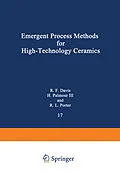This volume constitutes the Proceedings of the November 8-10, 1982 Conference on EMERGENT PROCESS METHODS FOR HIGH TECHNOLOGY CERAMICS, held at North Carolina State University in Raleigh. It was the nineteenth in a series of "University Conferences on Ceramic Sci ence" initiated in 1964 by four institutions of which North Carolina State University is a charter member, along with the University of California at Berkeley, Notre Dame University, and the New York State College of Ceramics at Alfred University. More recently, ceramic oriented faculty in departments at the Pennsylvania State University and Case-Western Reserve University have joined the four initial institutions as permanent members of the consortium. These research oriented conferences, each uniquely concerned with a timely ceramic theme, have been well attended by audiences which typically were both international and interdisciplinary in character; their published Proceedings have been well received and are frequently cited. This three day conference addressed the fundamental scientific background as well as the technological state-of-the-art of several novel methods which are beginning to influence present and future directions for non-traditional ceramic processing, thus affecting many of the advanced ceramic materials needed for a wide variety of research and industrial applications. The number, the importance and the application of new ceramic processing techniques have expanded considerably during the last ten years.
Inhalt
I: The Science Of Colloidal Processing.- Interfacial Electrochemistry of Disperse Systems.- How Colloid Stability Affects the Behavior of Suspensions.- Formation and Stability of Colloidal Dispersions of Fine Particles in Water.- Flocculation and Filtration of Colloidal Particles.- The Science of the Interactions of Colloidal Particles and Ceramics Processing.- Preparation of Shaped Glasses Through the Sol-Gel Method.- Inorganic Oxide Gels and Gel-Monoliths: Their Crystallization Behavior.- Boron Nitride Fiber Synthesis from Boric Oxide Precursors.- II: NOVEL POWDER-FORMING AND POWDER-PROCESSING METHODS.- Some Common Aspects of the Formation of Nonoxide Powders by the Vapor Reaction Method.- Synthesis of Powders and Thin Films by Laser Induced Gas Phase Reactions.- Preparation of Zirconia-Alumina Fine Powders by Hydrothermal Oxidation of Zr-Al Alloys.- Combustion Synthesis of Transition Metal Nitrides.- The Influence of Powder Synthesis Techniques on Processes Occurring During Compact Formation and its Sintering.- Dispersion and Packing of Narrow Size Distribution Ceramic Powders.- Plasma Sintering of Ceramics.- Plasma Melting of Selected Compositions in the A12O3-ZrO2-SiO2 System.- Liquid Phase Sintering of Ceramics.- Precision Digital Dilatometry: A Microcomputer-Based Approach to Sintering Studies.- III: Ceramics Derived By Polymer Processing.- The Conversion of Methylchloropolysilanes and Polydisilylazanes to Silicon Carbide and Silicon Carbide/Silicon Nitride Ceramics, Respectively.- Silicon-Nitrogen Polymers and Ceramics Dervied from Reactions of Dichlorosilane, H2SiCl2.- Formation of Ceramic Composites and Coatings Utilizing Polymer Pyrolysis.- Gas Analysis During the Pyrolysis of Carbosilane.- IV: Chemical Vapor Deposition.- Chemical Vapor Deposition of Ceramic Materials.- The Application of Thermodynamic Calculations to Chemical Vapor Deposition Processes.- CVD of Si3N4 and its Composites.- Preparation of Amorphous Si3N4-BN Composites by Chemical Vapor Deposition.- A Morphological Study of Silicon Borides Prepared by CVD.- A Morphological Study of Silicon Carbide Prepared by Chemical Vapor Deposition.- Low-Temperature Preparation of Pyrolytic Carbon.- Laser Chemical Vapor Deposition (LCVD).- V: Ion Beam Deposition.- Ion Beam Techniques for the Deposition of Ceramic Thin Films..- Ionized-Cluster Beam Deposition and Epitaxy.- Ion Beam Deposition of Ceramic-Like Coatings.- VI: Laser And Ion Beam Modification of Surfaces.- Laser Surface Melting of Metals and Alloys.- Laser Processing of Ceramics.- Microstructural Analysis of Rapidly Solidified Alumina.- Structure of Ceramic Surfaces Modified by Ion Beam Techniques.- Microstructure and Mechanical Properties of Ion-Implanted Ceramics.- Microhardness of N-Implanted Yttria Stabilized Zr02.- VII: Hot Isostatic Pressing.- Hot Isostatic Pressing of Ceramic Materials.- Dense Ceramic Parts Hot Pressed to Shape by HIP.- Fabrication of Si3N4 Ceramics with Additives of Metal Nitrides by High Pressure Hot-Pressing and HIPing.- Diffusion Bonding of AI2O3 and Ceramics by HIPing.- Relationship Between Densification and High Temperature Mechanical Properties of HIPed Silicon Nitride.- Microstructural Changes During Hot Isostatic Pressing of Sintered Lead Zirconate Titanate.- VIII: Dynamic Compaction.- Dynamic Compaction of Powders.- Dynamic Compaction of Ceramic Powders.- Explosive Consolidation of Aluminum Nitride Ceramic Powder: A Case History.- Computer Simulation of Dynamic Compaction.- Investigation of a Method to Consolidate Hard Materials in a Tough Matrix.- IX: Shock Synthesis: Shock Conditioning And Subsequent Densification.- Modern Uses of Explosive Pressure--From Rock Blasting to Synthetic Diamond.- Shock-Induced Modification of Inorganic Powders.- Densification Kinetics of Shock-Activated Nitrides.- Rate Controlled Sintering of Explosively Shock-Conditioned Alumina Powders.- X: Very High Pressure Processing.- High Pressure Processing of High Technology Ceramics.- Diamond Anvil Cell Technology for P,T Studies of Ceramics: ZrO2 (8 mol% Y2O3).- Effect of Strong Shock Compression on Covalent Materials and High Pressure Sintering.- A New Approach to the Reaction Sintering of Superhard Materials Under Very High Pressure.- Advisory committee.- Contributors.
